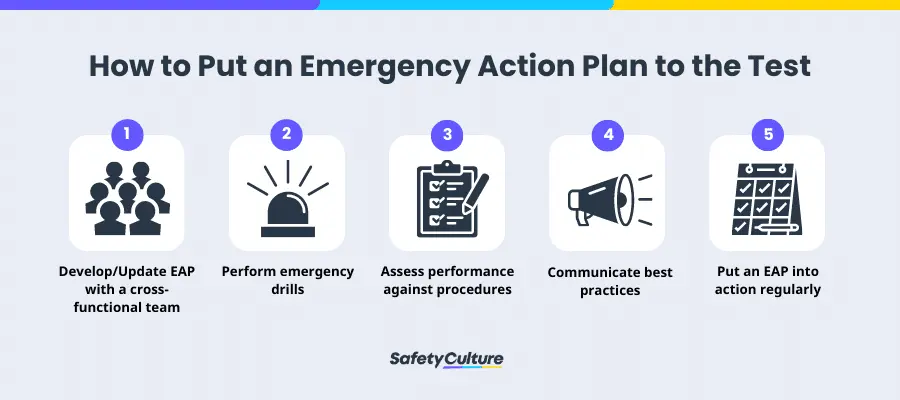What is an Emergency Action Plan?
An Emergency Action Plan (EAP) is a procedure that outlines how to respond and react during an emergency. An EAP describes who will take action with what tasks when there is an emergency, laying out specific steps that need to be taken for the organization or business to ensure people’s safety, property protection, continuity of operations, and minimizing business disruption.
Importance
An emergency action plan is vital for every organization to prepare and execute emergency management protocols and procedures. The purpose of an EAP is to help the organization eliminate confusion, injury, or property damage in case of a workplace emergency (e.g., blasting).
Regularly updating workplace emergency action plans empowers teams to recognize hazardous conditions that may worsen an emergency, allowing safety and health professionals to apply preventive measures. This practice also helps avoid devastating losses such as casualties and the financial downfall of an organization.
Benefits
Below are the main benefits of having an Emergency Action Plan in place:
- Facilitate workplace emergencies – Employers must have a plan for workers to follow in an emergency. This plan should include specific steps for employees, such as locking all doors, closing windows, turning off lights, and gathering in designated areas away from danger.
- Injury rates are lower and less severe – Having a plan and regularly training employees on what to do during an emergency can help reduce the risk of injuries.
- There is less damage to the structure – An EAP can help you identify the steps needed to protect your building and property, such as shutting off gas and electricity or taking other preventive measures.
- Reduce financial losses – An EAP helps you plan by outlining procedures to minimize financial losses in an emergency. And it can help you complete the paperwork correctly so that your claim is processed as quickly as possible.
- Ensure continuity of operations – An EAP also provides instructions for maintaining operations after an emergency. For example, it can describe strategies for keeping essential functions running during a power outage or suggest alternate locations if a facility is unavailable.
Who Needs an Emergency Action Plan?
As defined by the Occupational Safety and Health Administration (OSHA) in Standard 1910.38(a), every company or organization must have an EAP. Everyone can benefit from creating an EAP, from small firms to large organizations. It’s vital for companies with guests, customers, or on-site travelers, as well as those operating in risk-prone areas. An EAP can guarantee that everybody knows probable dangers and understands how to react if an unexpected situation occurs.
Create your own Emergency Action Plan Template
Build from scratch or choose from our collection of free, ready-to-download, and customizable templates.
Browse Emergency Action Plan TemplatesWhat to Include in an EAP
No two EAPs are alike, and the particularities of each will depend on many factors, such as building construction, operating hours, staff qualifications, and more. However, there should typically be some essential components incorporated into most EAPs, including:
Procedures for Evacuation, Escape Routes, and Floor Plans
Detailed diagrams of building layouts are a crucial component of each EAP. No matter the emergency, it must feature an updated diagram for the whole property. The map should include marked pathways to safety, and all emergency exits must be unmistakable.
Instructions on How to Report and Alert Authorities
It is important to remember that specific emergencies require the presence of specialized emergency responders, such as a hazardous materials unit for chemical spills or a utility company for power lines and utility issues. Therefore, the EAP must have all relevant contact information and emergency numbers.
Procedures for Alerting Staff and Visitors During an Emergency
Other than calling on the proper authorities, it is crucial to properly communicate that an emergency is happening. For instance, sounding the fire alarm is possibly the most effective approach to facing flames. Other alert systems may entail blowing a whistle or striking a bell.
Accounting for Everyone After Implementing an EAP
In an emergency, simplify accounting for personnel by printing a roster and having individuals indicate their safety from a designated area.
Procedures for Notifying the Parents, Guardians, or Next of Kin
Once an EAP is implemented, it can be necessary to tell parents, guardians, or next of kin connected to the persons concerned. Depending on the situation, family members may have to be told immediately to bring advice or come and take their kids away.
Procedures for Identifying a Media Contact Person
A reporter may contact your organization in an emergency to get information. Addressing the press is imperative, so you should appoint one person in your organization as the contact for media inquiries.
Instructions on How to Train New Staff
New staff must be familiar with the emergency exits in emergencies. For example, if there was a chemical spill, staff should be trained to stay away from the exits closest to the area and find another means of evacuating the building safely.
How to Put an Emergency Action Plan to the Test
Since emergencies in the workplace will occur, health and safety managers should ensure that every worker is prepared to respond accordingly. Follow these simple ways to integrate the practice of an emergency action plan in your organization:

1. Develop or update the emergency action plan with a cross-functional team
The Canadian Centre for Occupational Health and Safety (CCOHS) recommends that relevant individuals, such as employees with knowledge of the work, employees with experience in investigations, and representatives from the local government, should participate in establishing or reviewing emergency procedures. Working with a cross-functional team makes EAP all-encompassing, accurate, and effective.
2. Perform announced or unannounced emergency drills
With an EAP in place, the designated responsible official should conduct an organization-wide emergency drill to determine how effectively the plan is carried out. Announced emergency drills remind emergency coordinators to review the emergency action plan, while unannounced emergency drills demonstrate how they understand what to do at the onset of emergencies.
3. Assess performance against procedures in the emergency action plan
Upon completing emergency drills, gather a cross-functional team to analyze the results. Determine the root cause of misalignment, if there’s any, and exchange ideas about what can be done to maintain a high level of proficiency. The OSHA EAP template contains 21 critical questions to help assess the effectiveness of an emergency action plan.
Improve your EHS Management
Cultivate a safe working environment and streamline compliance with our EHS solutions.
Explore now4. Communicate best practices and changes to be applied
Positive reinforcement makes it easier for employees to keep doing what they do right. The designated official and emergency coordinators should call out best practices. Changes to be applied for areas of improvement should be paired with proper training to sustain retention.
5. Put an EAP into action regularly
OSHA advises annual emergency drills to effectively implement an emergency action plan. SafetyCulture suggests putting the plan to the test periodically to ensure the effectiveness of site-specific emergency procedures and continuously build a proactive safety culture in the workplace.
FAQ About Emergency Action Plans
EAPs should be inspected and improved annually or more often as called for. The documentation should note any upgrades. Fresh recruits, building reconfigurations, new ventures, office transformations, makeovers, and even more can all impact the potency of an EAP.
Measuring an emergency plan’s success largely depends on how quickly it can restore normal operations after a major incident. It is a crucial measure because even short downtime can cost businesses dearly—potentially making the difference between survival and failure.
Employers must review the emergency plan with each employee following OSHA regulation [29 CFR 1910.38(e)], both when the plan is created and when the employee first takes up their role. It ensures that every employee knows what to do in an emergency and is kept up-to-date with any changes.
It is the employer’s responsibility to establish and implement emergency action plans, as well as share information about them. However, it is also the responsibility of the employee to remember these plans and follow them.
A good emergency plan contains the following:
- Contact details of who to contact in case of emergency
- Evacuation plans that consider different locations and situations
- Proper practices to follow when evacuating or dealing with a risk
- Plans for what to do after an incident




